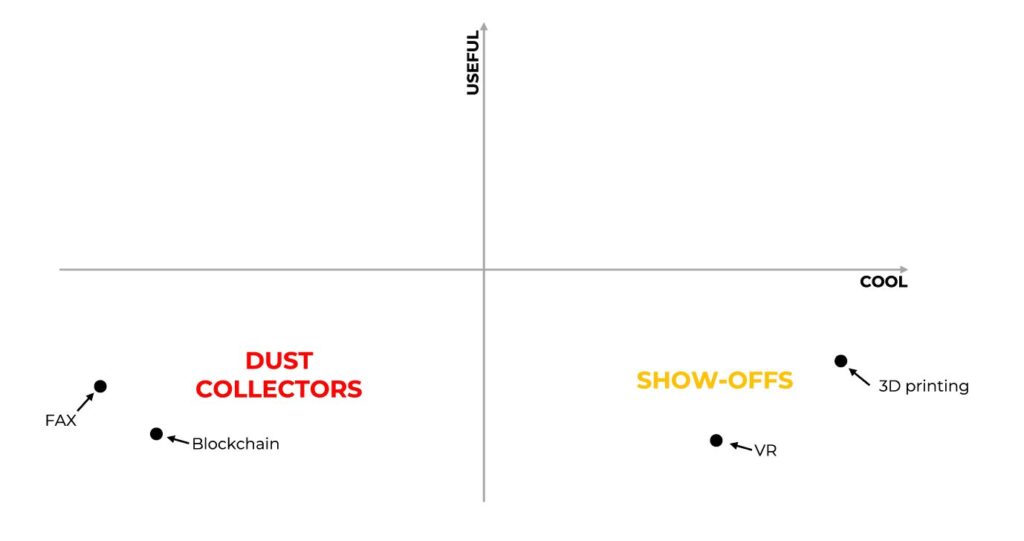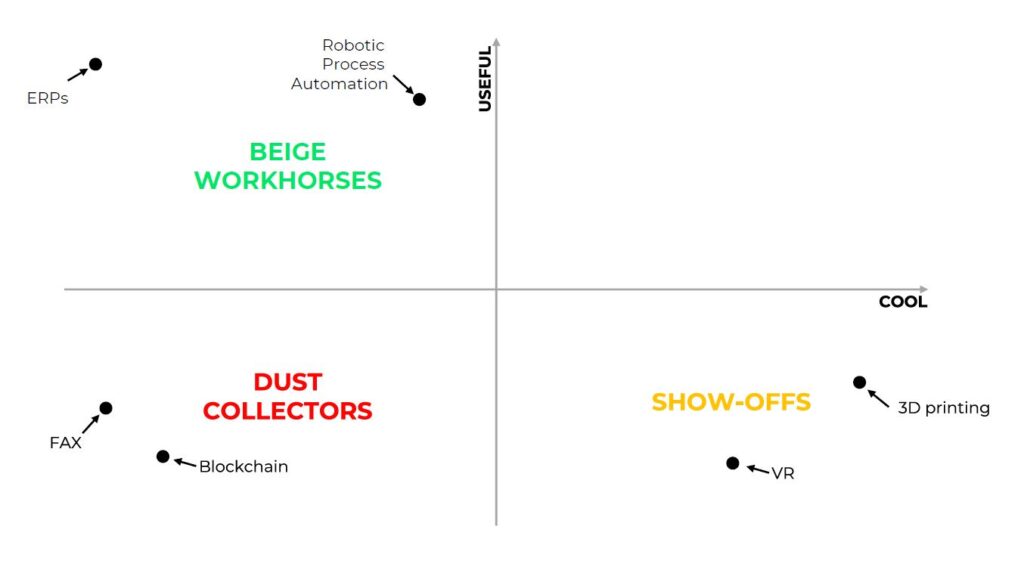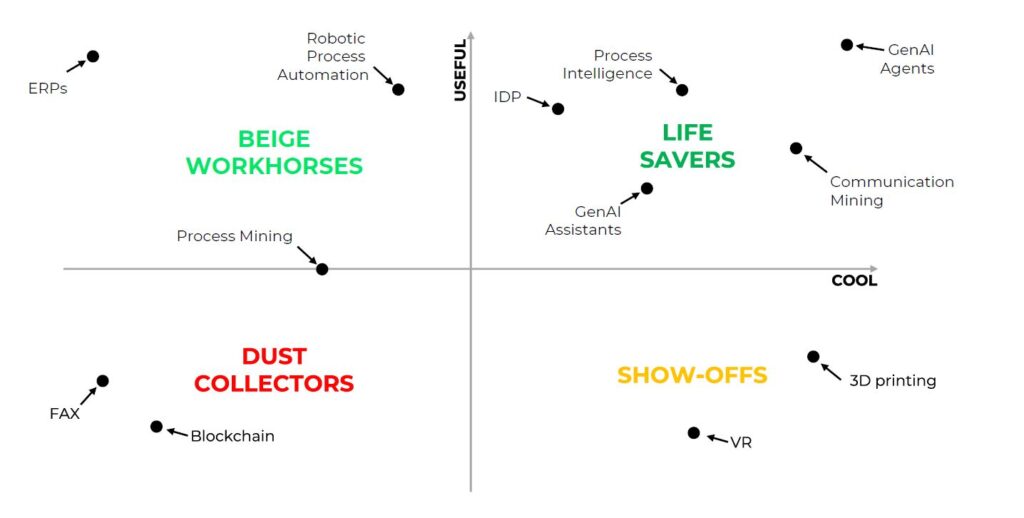Introduction: Cutting the hype like Hattori Hanzo
Welcome everyone to the Office Samurai podcast, where we cut through the hype like Hattori Hanzo through his enemies. We’re going to be discussing all the topics that you’re interested in: Automation technologies like RPAs, IDPs, APIs, LLMs, and all the three-letter acronyms you may think of, Communications mining, process intelligence, and AI. There has to be AI involved.
I’m your host Andrzej Kinastowski, one of the founders of Office Samurai, the company that dares to ask “What if we did business consulting without all the bullshit?”. So whether you’re a business leader, a tech geek, or just someone who wants to automate their email responses to say “Sure let’s circle back on that” you’re in the right place. Now grab your favorite katana or just a really sharp pencil and let’s get to it. Me and Dominik, the other founder of Office Samurai, we discuss technology a lot, as we are a technology consulting firm, and our customers expect us to be able to tell them which technologies will work for them.
The problem: why is choosing technology so difficult?
Our customers expect us to identify which technologies will not only solve their problems today but will keep on solving their problems in the future. This has proven to be somewhat difficult. We had a lot of hits – technologies that made all the sense and are working really, really well. But we also had some misses – technologies that somehow did not work. It has not necessarily been about the technology not being good; sometimes the technology is great, but it just doesn’t work, it doesn’t get implemented enough, and in the end we have to abandon it. We’ve been thinking, how do we judge which technologies will work in the future and which will not? I started searching for some theory that maybe would tell us how to tell those great technologies with great future from technologies that in the end will not work. Unfortunately, I couldn’t find any. So I thought, I’m going to have to do it myself; I’m going to have to come up with a unified theory of technology in business processes.
The unified theory of technology: Kinastowski’s Principle
I came up with this unified theory of technology. And I thought I’m going to call it the Kinastowski’s Principle. And then I’m going to write a book about it, and spend the next few years going from conference to conference talking about it. This theory aims at helping us and our customers to decide on which technologies to use and which technologies to abandon.
When we’re thinking about technologies, usually what we judge them by is how useful is this technology. This makes sense because the usefulness of a technology gives us an idea of how much it will help me, basically what the return on investment (ROI) will be. But this is only one axis on which I would like to judge technologies, because the other axis will be how cool is this technology. So with this, we can judge both the usefulness and the coolness of the technology.
The coolness of the technology has two sides. If the technology is really cool, there is a lot of hype around it, and sometimes we make decisions based on this hype, which may not be the best decisions. On the other hand, if the technology is really cool, it is way easier to convince your organization, to convince your sponsors, to get this technology implemented. So the coolness of technology can also be a great benefit to your projects.
Quadrant I: Dust collectors (low usefulness, low coolness)
This quarter of technologies, characterized by low usefulness and low coolness, we’re going to be calling dust collectors. Those are technologies that maybe someday, like a fax machine, they have been cool and they have been very useful, but over time they have proven to be outdated or not applicable at all.
Blockchain and Cryptocurrencies: The case of SAP and the fate of bored apes
Let’s first think about blockchain. I have been to conferences around 10 years ago where people would tell me that in 10 years all of the accounting will be made on blockchain. Ten years have passed, and I don’t really see SAP closing their business somehow; it just didn’t happen.
We rather know other ways of implementing blockchain, like Bitcoin. We’re at the beginning of 2025 and Bitcoin is on the rise again, but the exchange rate of Bitcoin is basically random. So there isn’t much use in business processes that we could utilize this blockchain implementation in our companies. Another example is NFTs. They were all the rage at a certain point. But if you did follow this hype, you are left with some Bored Apes that nobody wants to buy off you.

While there are certain niche ways to use blockchain in your business processes, like smart contracts, we could say that for most of the companies blockchain is not very useful. So it is low on usefulness and low on coolness. Blockchain in 2025 in business processes is a little bit less useful but a little bit more cool than a fax machine.

Quadrant II: Showoffs (low usefulness, high coolness)
This is the kind of technologies that are low on usefulness but they are really cool. This is the quarter that I would call showoffs. Those are technologies that everybody wants to get their hands on, but there isn’t that much business sense in using them, at least at this very moment.
VR and 3D Printing: Cool tech that doesn’t work in the office
The next technology is VR. Mark Zuckerberg told us that we’re all going to spend our days with VR headsets on our heads when working from home, which clearly is not something that we want. The technology has proven to be very expensive and quite problematic for people to bear in the long run.

It looks like in business processes it just doesn’t work. There are certain ways where VR makes a lot of sense in manufacturing, especially in training. I have talked to a company that uses VR headsets to train people in operating their machinery, and it makes all the sense. But having those VR headsets on our heads while we’re working just doesn’t seem to work. VR is a really cool technology, so we put it high on the coolness side. When it comes to usefulness, it’s very, very low in business processes.
This is kind of the same thing like with 3D printing. 3D printing in manufacturing may work for a lot of things, and it is a really, really cool technology. But when it comes to working in the office, until we get a 3D printer that can print me a hamburger for lunch, it just doesn’t work; it doesn’t make business sense.

Quadrant III: Beige workhorses (high usefulness, low coolness)
This is a quarter – low coolness but high usefulness – that I would call beige workhorses. They are beige because those technologies are no longer that exciting or new. But they are workhorses because they keep your enterprise running. Without ERPs or without RPAs, a lot of companies would basically just stop.
Robotic Process Automation (RPA): Business as usual

The next technology is robotic process automation (RPA). RPA is a technology that nowadays basically everybody uses; it used to be just for big enterprises, but now even medium and small companies are using RPA to automate their processes.
We should be thinking about RPA being very useful because for a lot of companies, a lot of their processes are already running with RPA. So the usefulness is really, really big. But the coolness of the technology is no longer there. They have become less cool because robots are now business as usual. In the same way that ERP systems many years ago were something new and exciting, nowadays nobody will say, “Oh my god, you have SAP! That is so cool”. ERP systems and RPA are technologies that are really, really useful for our companies, but they are just not cool anymore.

Quadrant IV: Lifesavers (high usefulness, high coolness)
This quarter of highly useful and highly cool technologies I will call lifesavers. They are lifesavers because they solve problems that you couldn’t solve with other technologies in the past. And because they are cool, it’s easier to convince your management to give you money to implement them and easier to convince your organization.
Process Intelligence (PI): Insight into what people are really doing
Process Mining is a difficult topic because it is really complicated. It takes highly skilled people and a lot of time to implement it. Once implemented, you see what’s going on in your processes from the perspective of your main system or main systems, but you are blind to everything else that is going on around those processes. Process Mining is probably on the lower side of coolness now.
There is, however, a set of new technologies called process intelligence. We used to call those technologies task mining, but they are now way more than that. Process intelligence is basically trying to see not only what’s going on in your processes, but it’s trying to see what are your people doing, really. In Process Mining, you are blind to things like Teams and Excel and email. In Process Intelligence, you install an agent on your people’s computers, and those agents look at what your people are doing in all applications. These tools record what they are doing, how often they switch between those applications, where they copy the data from and to, and they are able to understand your processes in all of the applications. This gives you amazing insight.

We had really successful implementations where our customers found opportunities for automation and process improvement. Process intelligence I would put high on the coolness side and also high on the usefulness side because it brings you a lot of benefit and it’s a new and exciting technology.
Intelligent Document Processing (IDP): From OCR masks to Machine Learning
Another technology that goes into this quarter is IDP, or Intelligent Document Processing. This is what we used to call intelligent OCRs, but the OCR element is no longer that relevant; it’s the intelligent part. IDP technologies are able to look at structured and semistructured documents and get data from them. In the past, manually booking invoices was a boring and tedious task.

Finding the right information on an invoice is not easy for a machine because every invoice from every company has its own layout. Old OCRs relied on what we called masks. For every new invoice template, you would have to create a mask. This required a lot of work and wasn’t perfect; if the layout changed just a little bit, the tool no longer worked. I have been part of a project where we found that teams were spending more time on fixing the mistakes the OCR was doing than they would have if they just booked all those invoices manually.
IDP now has machine learning algorithms that you can actually teach. A lot of documents it will be able to read out of the box, but then you can keep on teaching it. The documents that it isn’t able to read go to verification stations, where a user shows the tool where certain fields are. The data from those verification stations is used to retrain the model, so in time, its quality is getting better and better. IDP clearly goes into lifesavers. Those technologies are extremely, extremely useful.
Communication Mining: Solving freestyle communication
Communication Mining helps you do what IDP does for structured and semistructured documents, but for unstructured data, mostly communications. Even though it’s 2025, we still get a lot of freestyle communication flowing within our organizations; people will still open tickets and write emails with requests instead of using forms. This is the kind of data that is insanely hard for computers to understand.

Now we have tools with advanced machine learning abilities that are really easy to use. You put emails or tickets into the tool, and you teach the model what kind of requests you get. Then for every kind of request, you show it what we call entities that you need to find (e.g., SAP document numbers for GL clearing). Like with IDP, you teach the model on verification stations by “painting” over the necessary fields. This creates a situation where a lot of communication can be automatically processed.
The tool will be processing tens of thousands of emails, so the return on investment is absolutely crazy. Communication Mining goes into high usefulness and really high coolness because this is the technology that solves problems that were basically unsolvable two or three years ago.
GenAI Assistants and Cyber Ola
We all have been quite disillusioned with chatbots, but with large language models (LLMs), the game has changed because LLMs are very good at conversing with people. While training an LLM requires insane computer power and costs a lot (at least a few million), you can create assistants that are able to answer questions based on the knowledge of your company without training the model.

One of those we have in our company that we call Cyber Ola. We taught this GenAI assistant all of our admin and HR procedures using about 40 big documents. Our employees can ask Cyber Ola questions on Teams and get answers based exactly on that knowledge. We were able to make it not hallucinate; if it doesn’t have the answer, it just says, “I don’t know, go ask a biological Ola”. When it provides an answer, it also tells you which document or documents it has taken the answer from. GenAI assistants go into highly useful and also highly cool technologies.
GenAI Agents: The future of automation
GenAI assistants are just something that we do before we take the next step, because all the rage right now is on GenAI agents. We already see that there’s huge potential in those agents.

Our Cyber Ola is getting new features – agentic features. Our employees can not only ask it questions, but for certain questions, it will also offer doing the thing for an employee. For instance, if they ask how to get a refund for their glasses, Cyber Ola will tell them how to get the refund, but it will also ask, “Would you like me to do it for you?”. Through a set of APIs that we have programmed into it, it is able to fill the form in and send it to our admin and HR. Smaller and bigger things that we used to call GenAI assistants can now do, which makes them GenAI agents.
This is something that will change the way we work; a lot of the things that we do now or we have to bother other people about now will be done by those GenAI agents. If you look at what the technology can do for your organization already, you can have a huge impact. From the user perspective, it’s extremely easy to use; you can connect it to a chat, Teams, or a Zoom chat, and business users interact with it very naturally. GenAI agents go into really high usefulness and really high coolness.

Conclusion: Summary and farewell
And that’s a wrap for this episode of the Office Samurai podcast. This episode wouldn’t be possible without the sharp skills and stealthy moves of Anna Cubal, our producer and resident wrangler of chaos. We record this podcast in the mighty Wodzu Beats Studio. If you like what you heard, subscribe, leave us a review, and follow us on social media. Got questions, feedback, or just want to tell me I mispronounce Hattori Hanzo, drop us a message. Until next time, now go and save the world or at least a little bit.




